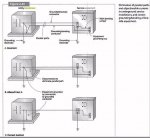To me in figure 5 you would need to extend the equipment grounding conductor to the disconnect and remove the neutral to case bond and seperate the neutral and ground in the disconnect.
The way figure 5 is drawn now the neutral return current would be traveling over the noncurrent carrying parts since they are bonded together. Worse yet, if you lost the neutral between the transformer and the disconnect all of the return neutral current would be resting on the noncurrent carrying parts just waiting on path back to its source.
I've already probably said more than I know.
The way figure 5 is drawn now the neutral return current would be traveling over the noncurrent carrying parts since they are bonded together. Worse yet, if you lost the neutral between the transformer and the disconnect all of the return neutral current would be resting on the noncurrent carrying parts just waiting on path back to its source.
I've already probably said more than I know.


